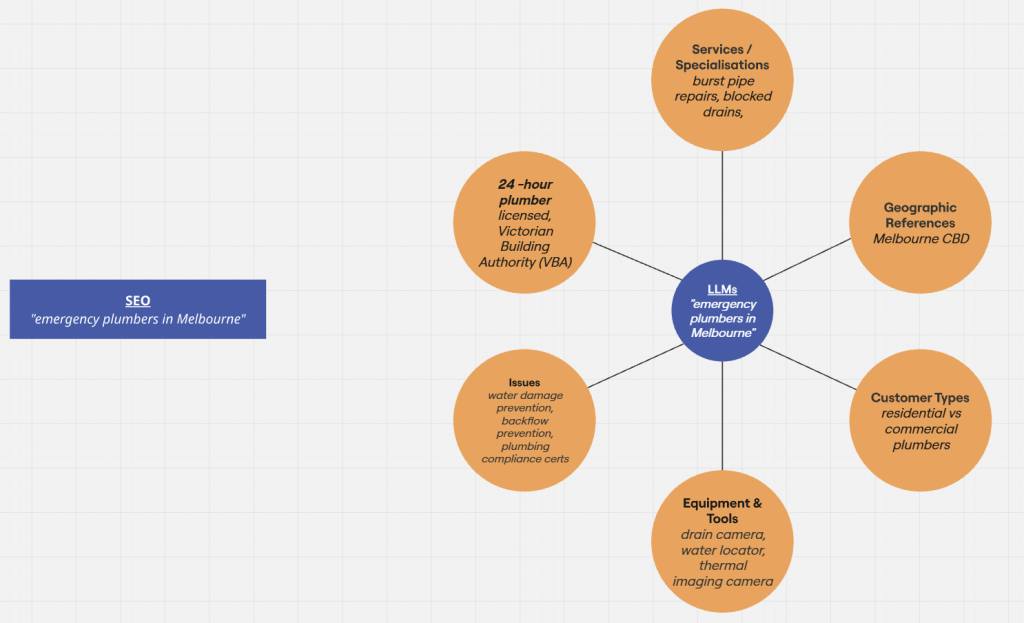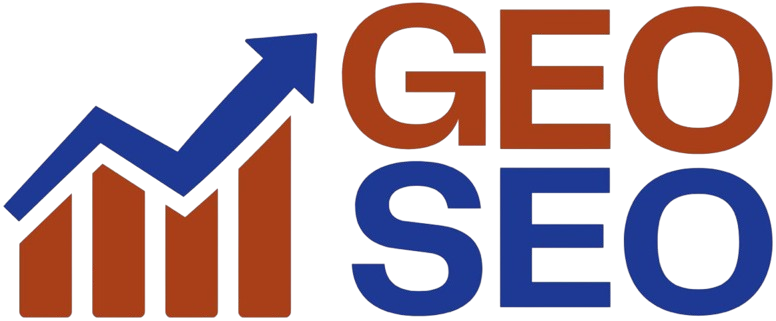The search landscape is changing faster than most marketers and business owners realise. As generative engines like ChatGPT, Perplexity, and Google SGE shape how people discover information, the way we write and optimise content needs to change.
For years, the focus of SEO was keywords and exact phrases typed into that search bar. Now, with generative AI search, visibility is less dependent on those keywords, and more on concepts, entities, and relationships.
If you want your website to appear in AI-generated searches, you’ll need to bridge the gap between keywords, concepts, and entities, and build topic clusters that speak the same language as the AI agents behind generative search.
In this post, we give you actionable tips on how to do just that.
From Keywords to “Entities”
Traditional SEO treats language and sentences as strings of text.
AI search systems treat it as a web.

For example, let’s say a user types in “emergency plumbers in Melbourne”, Google search results would likely show web pages that contain said phrase.
If you plug that into ChatGPT, the AI model would look for entities, e.g., people, companies, and concepts that surround “emergency plumbers” and “Melbourne“. AI doesn’t just index words. It interprets things and their relationships. Here are some examples of entities related to our search phrase;
-
- Core entities: emergency plumber, 24-hour plumber, after-hours plumber, licensed plumber, Victorian Building Authority (VBA), Master Plumbers Association of Victoria
-
- Services & Specialisations: burst pipe repair, blocked drains, blocked toilets, blocked sinks, water leak detection, tap and toilet repairs, pipe relining
-
- Geographical Entities: Melbourne CBD, specific inner suburbs, specific outer suburbs, greater Melbourne, Metropolitan Melbourne
-
- Customer & Property Types: Residential plumbing, commercial plumbing, industrial plumbing, strata, real estate, aged care facilities, schools, retail
-
- Equipment & Tools: drain camera, high-pressure water jet, pipe locator, thermal imaging camera
-
- Related Concepts & Issues: water damage prevention, backflow prevention, water pressure regulation, plumbing compliance certificates, same-day service
-
- Local SEO & Marketing Entities: Google Business Profile, Google Maps listing, review platforms, directories, competitors, service area pages
The above isn’t even a full exhaustive list of entities, but as you can see, there’s a lot to cover. Information is not only an SEO fundamental, but a requirement to obtain visibility within generative AI-based searches.
Next, we’ll go into some steps on how you can integrate these concepts and entities to help drive visibility and get AI agents to cite your content.
Steps to Help Shift Your Content Towards Entities
1) Map Entities Behind Your Keywords
Search engines and LLMs reward brands that fully cover topics. To bridge this gap, start by mapping entities behind your target keywords.
For example:
Keyword: “AI search optimisation”
Entities: ChatGPT, Google Gemini, Perplexity, structured data, LLMs, llms.txt, knowledge graphs, and GEO strategy to name a few.
Each of these entities helps AI understand the topic, contextually. The more clearly your content connects these entities, the more semantically relevant you become.
Actionable Steps for Entity Mapping
-
- Use tools like Google’s Knowledge Graph, People Also Ask, and Related Searches to identify related entities
-
- Use ChatGPT prompts such as: “List the entities and related concepts associated with [keyword].”
-
- Once you have your entities, link between them naturally such as by mentioning them within the same paragraph or section to help signal conceptual relationships.
2) Build Conceptual Relevance
After you’ve mapped your entities, strengthen how they connect.
AI models reward context bridges, which are sentences and paragraphs that show how entities interact within real-world meaning.
For example:
“ChatGPT and Perplexity both use large language models (LLMs) to summarise content, but each platform applies its own citation logic when referencing online sources.”
This does more than explain, it tells the AI that your brand understands how entities relate.
Actionable Steps for Building Conceptual Relevance
-
- Write with co-mentions (e.g., “ChatGPT” + “Gemini” + “AI Overviews”).
-
- Include semantic variations (“AI search visibility,” “LLM-driven search,” “AI SEO”).
-
- Use structured data (FAQ, HowTo, Organization, Service, Product, etc.). This gives LLMs a machine-readable understanding of your expertise.
3) Structure Your Site Around Topic Clusters
In SEO, these are known as “content pillars”. With AI now in full effect, how we organise our content must evolve.
Instead of grouping pages by keyword intent (like “how to” or “benefits”), structure them according to the relationships between the entities.
Example of an AI Search Optimisation Topic Cluster
-
- Pillar Page: What is AI Search Optimisation (GEO)?
-
- Supporting Topics:
-
- How AI Platforms Choose Their Sources
-
- The Role of llms.txt in AI Visibility
-
- Entity SEO vs Keyword SEO
-
- How to Get Your Brand Cited in ChatGPT
-
- Schema and Structured Data for AI Search
-
- Supporting Topics:
Each of these topics supports the core concept and helps strengthen your brand’s entity authority, the web of context the LLMs use to determine expertise.
Actionable Steps for Structuring Topic Clusters
-
- Start with one pillar topic (your core entity)
-
- Identify parent, child, and sibling entities:
-
- Parent: Generative AI, SEO
-
- Child: ChatGPT citations, LLM schema
-
- Sibling: AI content optimisation, entity SEO
-
- Identify parent, child, and sibling entities:
Build internal links that connect them clearly as they signal semantic relevanct to both search engines and AI crawlers.
4) Identify Topic Cluster Gaps
This step requires you to look through your website’s copy for information that should be there, but isn’t. Ask yourself:
-
- Which related entities are not yet covered on my site?
-
- Are there connection points missing between related ideas?
-
- Do I explain why these entities matter together, not just what they are?
Actionable Steps to Identify Topic Cluster Gaps
-
- Use Google’s “People Also Ask”, Perplexity’s related questions, or Semrush’s Topic Research to spot missing relationships
-
- In ChatGPT or Perplexity, you can use this prompt: “List under-explored topics connecting [entity A] and [entity B] in the context of [industry].”
-
- Fill these gaps with education, data-backed, and interlinked articles.
5) Think Like an LLM
Large Language Mdodels (LLMs) don’t just read, they connect.
They “understand” your brand when it’s mentioned across multiple, related topics, when it consistently links authoritative entities, and when it’s cited or referenced alongside recognised experts or brands.
The goal to “rank for a keyword” is now becoming replaced by becoming a recognised entity in the conceptual web surrounding your niche.
Actionale Steps for Thinking Like an LLM
-
- Establish consistent Author and Organization schema
-
- Reference authoritative sources (and let others reference you).
-
- Use structured data and clear contextual links across your content network.
The Takeaway
The future of SEO isn’t about optimising for search engines alone anymore, it’s about being clearly understood and cited by AI systems and LLMs.
SEO is moving from;
-
- Keywords to Entities
-
- Pages to Contextual Clusters
-
- Rankings to Recognition
If you can create content that speaks the same semantic language as LLMs, you won’t just appear in Google’s search results and AI overviews, but you’ll become a part of the knowledge base they draw data from.
Overview
If you’r ready to future-proof your brand’s visibilty in both the Google and AI platforms:
-
- Map your entity ecosystem.
-
- Restructure your site around conceptual topic clusters.
-
- Optimise your content for AI understanding, not just Google rankings.
Get Found in AI Search
We optimise websites for this developing landcape. You can learn more about us and our process or check out some results we’ve achieved for our clients.
If you’d like to learn more and talk GEO strategy for your business, shoot as an email at geoseodigital@gmail.com.
